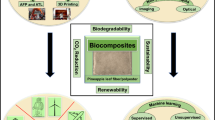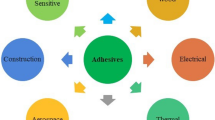Abstract
Taguchi method has been widely and successfully used for more than two decades to improve the quality and performance of the product. In this research article, grey-based Taguchi method was implemented to optimize the operating parameters of dry sliding abrasive wear behavior of areca sheath fiber reinforced polyvinyl alcohol composites. Composites were prepared by incorporating randomly oriented benzyl chloride-modified areca sheath fibers taking 10, 20 and 30 wt% and experiments were conducted according to Taguchi’s L27 orthogonal array by considering three factors and three levels affecting the abrasion process using pin-on-disc apparatus. Grey relational analysis was utilized to optimize the multi-response tribological parameters. Analysis of variance was utilized to determine the importance of factors affecting wear the most. The specific wear rates for all the composites were also compared and discussed. The optimum process parameter which gives the best multiple response characteristics was found to be load 15 N, sliding velocity 0.392 m/s and filler content of 30 wt%. An improvement of 4.19% in GRG was observed after confirmation test which proves that the multiple performance characteristics of the natural fiber reinforced polymer composites can be adequately enhanced by this technique. Scanning electron micrographs were obtained at the optimum setting to support the findings.






Similar content being viewed by others
References
Berthet M, Coussy HA, Guillard V, Gontard N (2015) Vegetal fiber-based biocomposites: which stakes for food packaging applications? J Appl Polym Sci 133:1–18. https://doi.org/10.1002/app.42528
Adekunle K, Cho SW, Ketzscher R, Skrifvars M (2012) Mechanical properties of natural fiber hybrid composites based on renewable thermoset resins derived from soybean oil, for use in technical applications. J Appl Polym Sci 124:4530–4541. https://doi.org/10.1002/app.35478
Prajer M, Ansell MP (2014) Bio-composites for structural applications: poly-l-lactide reinforced with long sisal fiber bundles. J Appl Polym Sci 131:1–13. https://doi.org/10.1002/app.40999
Armioun S, Panthapulakkal S, Scheel JU, Tjong J, Sain M (2016) Biopolyamide hybrid composites for high performance applications. J Appl Polym Sci 133:1–9. https://doi.org/10.1002/app.43595
El-Tayeb NSM, Yousif BF, Yap TC (2006) Tribological studies of polyester reinforced with CSM 450-R-glass fiber sliding against smooth stainless steel counterface. Wear 261:443–452. https://doi.org/10.1016/j.wear.2005.12.014
Medalia AI (1980) On structure property relations of rubber. In: Proceedings of the international conference, Kharagpur, p 13
Chand N, Naik A, Neogi S (2000) Three-body abrasive wear of short glass fibre polyester composite. Wear 242:38–46. https://doi.org/10.1016/S0043-1648(00)00398-7
Basavarajappa S, Yadav SM, Kumar S, Arun KV, Narendranath S (2011) Abrasive wear behavior of granite-filled glass-epoxy composites by SiC particles using statistical analysis. Polym-Plast Technol Eng 50:516–524. https://doi.org/10.1080/03602559.2010.543734
Padhi PK, Satapathy A (2013) Analysis of sliding wear characteristics of BFS filled composites using an experimental design approach integrated with ANN. Tribol Trans 56:789–796. https://doi.org/10.1080/10402004.2013.798448
Yousif BF, Umar N, Wong KJ (2010) Three-body abrasion on wear and frictional performance of treated betelnut fibre reinforced epoxy (T-BFRE) composite. Mater Des 31:4514–4521. https://doi.org/10.1016/j.matdes.2010.04.008
El-Tayeb NSM (2009) Two-body abrasive behaviour of untreated SC and R-G fibres polyester composites. Wear 266:220–232. https://doi.org/10.1016/j.wear.2008.06.018
Singh N, Yousif BF, Rilling D (2011) Tribological characteristics of sustainable fiber-reinforced thermoplastic composites under wet adhesive. Wear Tribol Trans 54:736–748. https://doi.org/10.1080/10402004.2011.597544
Tong J, Ma Y, Chen D, Sun J, Ren L (2005) Effects of vascular fiber content on abrasive wear of bamboo. Wear 259:37–46. https://doi.org/10.1016/j.wear.2005.03.031
Chand N, Dwivedi UK (2007) High stress abrasive study on bamboo. J Mater Process Technol 183:155–159. https://doi.org/10.1016/j.jmatprotec.2006.09.036
Chand N, Dwivedi UK, Acharya SK (2007) Anisotropic abrasive wear behaviour of bamboo (Dendrocalamus strictus). Wear 262:1031–1037. https://doi.org/10.1016/j.wear.2006.10.006
Rana AK, Mitra BC, Banerjee AN (1999) Short jute fibre-reinforced polypropylene composite: dynamic mechanical study. J Appl Polym Sci 71:531–539. https://doi.org/10.1002/(SICI)1097-4628(19990124)71:4<531:AID-APP2>3.0.CO;2-I
Hashmi SAR, Dwivedi UK, Chand N (2007) Graphite modified cotton fibre reinforced polyester composites under sliding wear conditions. Wear 262:1426–1432. https://doi.org/10.1016/j.wear.2007.01.014
Bijwe J, Rajesh JJ, Jeyakumar A, Ghosh A, Tewari US (2000) Influence of solid lubricants and fibre reinforcement on wear behaviour of polyethersulphone. Tribol Int 33:697–706. https://doi.org/10.1016/S0301-679X(00)00104-3
Patnaik A, Satapathy A, Biswas S (2010) Investigations on three-body abrasive wear and mechanical properties of particulate filled glass epoxy composites. Malays Polym J 5:37–48
Suresha B, Chandramohan G, Mohanram PV (2009) Role of fillers on three-body abrasive wear of glass fabric reinforced epoxy composites. Polym Compos 30:1106–1113. https://doi.org/10.1002/pc.20662
Suresha B, Siddaramaiah Kishore, Seetharamu S, Sampath Kumaran P (2009) Investigations on the influence of graphite filler on dry sliding wear and abrasive wear behaviour of carbon fabric reinforced epoxy composites. Wear 267:1405–1414. https://doi.org/10.1016/j.wear.2009.01.026
Zum-Gahr KH (1985) Abrasive wear of two-phase metallic materials with a coarse micro structure. In: Luudema KC (ed) International conference on wear of materials, Vancouver. ASME, p 793
Keerthi A, Imaad S, Mark RM, Keerthan KS, Pavana KB (2015) Processing and characterization of epoxy composite with arecanut and casuarina fibers. Am J Mater Sci 5:96–100. https://doi.org/10.5923/c.materials.201502.20
Taguchi G, Konishi S (1987) Taguchi methods: orthogonal arrays and linear graphs. American Supplie Institute Inc., Dearborn
Montgomery DC (1991) Design and analysis of experiments. Wiley, Singapore
Ramesh BN, Suresha B (2014) Optimization of tribological parameters in abrasive wear mode of carbon–epoxy hybrid composites. Mater Des 59:38–49. https://doi.org/10.1016/j.matdes.2014.02.023
Deng J (1989) Introduction to grey system. J Grey Syst 1:1–24
Chowdhury MA, Khalil MK, Nuruzzaman DM, Rahaman ML (2011) The effect of sliding speed and normal load on friction and wear property of aluminum. Int J Mech Mechatron Eng 11:45–49
Subbaya KM, Rajendra N, Varadarajan YS, Suresha B (2012) Multiple response optimization of three-body abrasive wear behaviour of graphite filled carbon–epoxy composites using grey-based Taguchi approach. J Miner Mater Charact Eng 11:876–884
Roy KR (1990) A premier on Taguchi method. Van Nostrand Reinhold, New York
Author information
Authors and Affiliations
Corresponding author
Rights and permissions
About this article
Cite this article
Nayak, S., Mohanty, J.R. Optimization of operating parameters for abrasion of areca sheath reinforced polymer composite: grey based Taguchi approach. Int J Plast Technol 22, 26–40 (2018). https://doi.org/10.1007/s12588-017-9198-z
Received:
Accepted:
Published:
Issue Date:
DOI: https://doi.org/10.1007/s12588-017-9198-z




